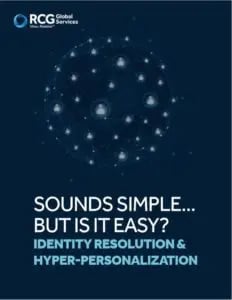Sounds Simple…But Is It Easy? Identity Resolution & Hyper-Personalization
Micro-personalization in this hyper business environment is the key to create a differentiated customer experience for all organizations
Customer Experience is the Key Brand Differentiator
Micro-personalization in this hyper-business environment is the key to creating a differentiated customer experience. A micro or atomic level of understanding the behavioral tendencies and the ability to derive insight for predictive and prescriptive offerings will be key to success. The ability to harness this insight and to engineer the necessary velocity to successfully go to market starts with a single version of the truth of who the customer is and what their value is to you. Sounds simple, but “is it easy?” Is your organization on track to capture market share?
- Why is identity resolution needed to meet the most pressing business objectives?
- What are the key components of an effective identity resolution program?
- What are the key steps to implementing an identity resolution initiative?
- How does this translate to a real-life case study?
- What are the resulting key benefits of identity resolution program?
Have you ever had one of those “Aha” moments where you looked at the world around you and saw things a bit differently? You know where the internal light bulb went off and you gained a completely different perspective. We all have. The complex daily life we lead has so many impediments that it sometimes seems overwhelming or insurmountable. And as a result, many times we tend to overthink and get analysis paralysis when trying to solve a problem. But often if you take a breath and step back you will tend to see that most situations distill down into something very simple if not always obvious. However, as we will discuss, simple does not necessarily mean easy. Take for example any sport. All you really have to do is score more points than the other person or team. Simple right? But any football, basketball, hockey, tennis, golf, race car driver or Olympic athlete will tell you – it is not easy.
Enable a Hyper-personalized Understanding of each of our Customers

We all know that for each of our organizations to meet their business goals we must have a hyper-personalized understanding of each of our clients’ tendencies and behaviors – individually – and there must be only one instance of that client and all their behavioral activities that exists on record within the multitude of internal systems and warehouses. We have been talking about the goal of attaining the holy grail of the 360-degree view of the customer for many years. It would not surprise me if most of the readers, if not all, have embarked upon a CRM upgrade initiative(s) over the past few years and may have gotten close to that complete view. I am sure it was a complex and daunting task, so I applaud you for your efforts. But in todays on-demand world are we really where we need or want to be yet? Probably not. So yes, we all get it – It’s simple, right? A single instance of the customer with a comprehensive picture of the relationship (and the potential values) – with an understanding of the behavioral tendencies -but is it easy? Let us take a look at how the path toward getting there can be made a bit clearer.
Identity resolution relates to achieving business objectives.

- Customer Experience Enhancement (and internal user experience which is just as important)
- Seamless and transparent omni-channel engagement model,
- Rapid response to customer activity that enhances experience,
- Retention of the best customers – holding on to what you have,
- Offloading undesirable and/or high cost to serve, unprofitable customers,
- Promoting growth of high-potential customers. CLTV – owning customers vs renting them,
- Attraction of profitable target prospects,
- Cost management of price-sensitive and low-margin customers,
- Enhancement of overall revenues, Growth and Profitability,
- Optimization of systems and architecture – move to cloud delivery,
- Fraud detection and prevention,
- Regulatory requirements – KYC.
And what do all these objectives have in common?
They all require that your organization know the customer. Like in any good data governance/data quality program there must be an embedded system of quality and governance over data assets that are owned and curated by data stewards. Every bit of data should ideally have one single version of the truth that exists in only one file space at any point in time. This of course, ensures accuracy in reporting, maintenance, and analyses of data to provide valid insights for action. The same holds true for the data asset known as the customer – there should only be one single verified and validated version of who that customer is. Again, it’s simple but is it easy?
But why is this important?
Industry Experts have spoken for many years about “data as an asset”, “monetization of data” and “data as the new currency”, but I think the past year has moved us beyond those terms and into a new realm where “velocity” becomes the newer value currency as speed-to-market and speed-to-customer are the result of having to run faster to capture the minds and hearts of the customer and to gain market share. In other words, in a world where 60Tn messages are sent out each day, how do you stand out?
We call this a step into the hyper-business age, where the goals at the macro company level are to get from strategy on paper, to execution, to impact in the shortest amount of time possible with the potential for largest returns and increased competitive advantage. It’s where intelligent automated systems combine with machine learning and work together at hyper-speeds to process bits of information and to make that information available for decisioning. This process enables insight value to be created when a connect-the-dots picture of client behaviors and relationships is generated of the and plotted using a tool called a real-time identity graph. The graph ideally is fluid and constantly being updated as the consumer continues to interact with the market, supplying additional behavioral data points that together weave the pattern of their lifestyle. The pattern is what drives the ability to hyper-personalize the offerings in a very directed, predictive, and prescriptive non-intrusive manner. But again, this only works if a single version of the customer identity exists as the “prima nota” or first note meaning the primal source. Using Data or Customer identities that have not internally been “certified” as “truth elements” will just lead to failed campaigns and failed revenue expectations. The results being only as meaningful and accurate as the integrity of your underlying data fields.
What is Identity Resolution?

It is the use of device identity, browser behavior, transaction insights and other contextual data to create a single view of each customer. But as we mentioned, this only works if you have a unique single version of truth for a customer identity (unique identifier) where that collected behavioral activity data is warehoused, organized, and retrieved and the relationship between all the activity nodes can be analyzed and understood.
This unique customer identifier is the central node in the identity resolution process. From this single node all behavioral activities and relationships are attached, analyzed and the complete picture of the client and the potential life-time value of the client begins to develop. But it is more than just looking at the behavioral data points that manifest – it is more about understanding the relationship between the data points and deriving insight from overall picture.
Painting an Identity Picture
Let us look at the world of music for a reference point. A very famous quote by Wolfgang Amadeus Mozart – “The music is not in the notes, but in the silence between”, or sometimes attributed to Claude Debussy – “Music is the silence between the notes” has relevance here. The take on that is “If you want to play music, you must pay attention not just to the notes, but play the spaces between them.” Think about it. If you sit down and play just one note on the piano, it is pleasing. It does not do much, but it sounds nice. When you play two notes in sequence, it gets more, “interesting” – one note may be louder than the other, one may sustain longer than the other, and one may change pitch, higher or lower. When you follow by playing three or four notes together you begin to create a melody with the intervals between the notes playing a more important role in forming a musical landscape. When you string these melodic landscapes together, it is the place where the symphony is born – where the magic happens. So, the relationship of the notes found in the space between the notes is very important. Likewise, it is also where the magic lives when analyzing the space and relationship between the behavioral activity nodes to create insight into how to create the holistic, yet singular picture of the identity of the customer and to set the stage for monetizing the data points to provide the micro-personalization.
Barriers to Identity Resolution
Trans Union talks about the change agents that affect us getting to a single truth of identity resolution:
- Regulation and data privacy standards – Privacy constraints driven by consumer sentiment, regulatory and browser crackdowns that have catalyzed a viewpoint that no single digital identifier is reliable,
- Deprecation of cookies and mobile identifier changes – Finding an alternative to cookies means looking beyond the next identifier,
- Increase in connected devices – An increase in devices, content and channels across the advanced market creating fragmented playing fields,
- Personalized experiences – A comprehensive understanding of consumer identity is needed to drive relevant, authentic experiences across digital touchpoints to meet expectations.
Key Identity Resolution Attributes and Core Tenets
To incorporate an effective identity resolution program some basic concepts must be present:
- Accuracy: Ensuring that you are messaging the correct message, to the correct person, across all devices, browsers, touchpoints and channels available,
- Recognition: The ability to identify the correct targeted client/addressable audience and market to them online and offline,
- Persistence: The ability to maintain a single accurate customer identity over a period of time that incorporates the changes that customers undergo during their lifetime journeys,
- Privacy and compliance: Ensuring that opt-outs and customer privacy controls are in place,
- Scale: The ability to scale the amount of the addressable audience a marketer can reach online and offline,
- Quality: a laser focus on the QUALITY of data being collected, analyzed, and used vs. QUANTITY,
- Approach: Deterministic vs. probabilistic approach
- Deterministic is where you resolve identities based on what you know to be true. It merges new data into customer records by searching for matches among the phone numbers, emails, device IDs, and user IDs you already have. Deterministic identity resolution is a high-confidence approach using first-party data where you know with certainty that this user did that. (Most commonly used approach),
- Probabilistic is where you resolve identities based on what you predict to be true. It uses predictive algorithms to understand who your customers likely are. Probabilistic identity resolution is a statistical model with a given confidence interval, where you know with a certain amount of confidence that this user will do that.
- Availability: an accessible Cloud based Customer data lake warehouse platform with intelligent automated workflow and case management to provide velocity.
Why is identity resolution so important?

There has been a blurring of industries and companies today realize that they are technology companies that “happen” to offer specific and products. Consumers demand services across all industries in an accelerated on-demand economy. They engage differently today than they did in the past. Retail customers use search engines and social media like Google and Facebook to find the best deals, then they can order just about any good or service from online companies like an Amazon. They are used to on-demand self-help environments that allow them to, at the time and place of their choice and on the device at hand, conduct business in the manner with which they choose
Banking Industry as an Example – Business Objectives
For customers, banking services will always be a necessary activity, but today they want it in context with their life moments and in a manner that mirrors their online life. As a result, banking products have become common and ubiquitous across financial institutions. The remaining avenue for differentiation and competitive advantage is a pleasant, simple, and stress-free customer interactive experience. Banks have basically only a few methods available to them to grow and become more profitable:
- Acquire new customers and/or broaden a customer base making revenue more disbursed across geographies or segments,
- Sell more product and services to existing clients,
- Sell profitable (vs. unprofitable) products to profitable existing customers,
- Simplify product and service offerings,
- Increase or expand interest rates, fees, and service charges,
- Reduce operating costs and cost-to-serve,
- Install advanced technologies to optimize performance and reduce overall costs,
- Acquire other bank(s) – integrate for economies of scale, new footprint or to remove competition,
- Or, most recently, establish partnerships with FinTechs, leveraging open banking API’s to link to their technology and offerings
And with these methods, historically there have been several customer and market risks that are associated with really knowing and trying to sell to your customers. The goal being to minimize and de-risk their impacts:
- Retention risk – Not being able to identify customers who are most likely to defect and why, and the costs associated with losing them vs. the value of keeping them,
- Growth and penetration risk – Not meeting growth and penetration goals and wasting marketing dollars by launching customer marketing product campaigns that incorrectly focus on the wrong segment(s),
- Attraction risk – Attracting the wrong segment or unwanted customers due to lack of understanding of targeting and wasting marketing dollars,
- Managed cost risk – Attracting high-cost-to-serve customers and low lifetime value customers who erode earnings and marketing funds,
And to that we could add two “new” risks that could be labeled:
- Intimacy risk – the risk of not “knowing” your existing customers and having them abandon you for lack of a unique hyper-personalized experience. (It has been reported that 74% of millennials would change banks if they received a negative customer service experience),
- Velocity risk – the risk of not acting or responding quickly enough to capture the “heart and mind” of the desired new or existing customer before someone else does.
How to step into the hyper-business, micro-personalized age

Raw Materials
- Begin with Knowing Your Customer – Integrate and augment with Identity Verification Solutions (IDV) and Customer Identity and access management solutions (CIAM),
- Ensure core systems and peripherals can support your new needs,
- Capture meaningful data points (ideally in real or near-real time) and incorporate newer alternate information sources (social media, etc.) into your model,
- Incorporate a robust governance and quality foundation that produces single-source, trusted data points for every bit of data including customer,
- Establish a warehouse for this information that will be an easy distribution point but is robust enough to accommodate the flood of available information soon to be generated by 5G and WiFi6.
Manufacture
Create services that allow you to capture, process and query/search data.
- Capture data coming at you from any source, any time, at any speed. Organizations are looking to make each customer interaction as memorable as possible in the moment,
- Process data and attach it to a person – whether a customer or a prospect – as quickly as possible. This will provide the opportunity to hydrate the workflow with connected information that is pertinent to the business process.
- Search for insights that are illuminated by the active data. Is an identity showing interest in a category of products? Can you drive them towards something more specific using additional data? Do you want to quickly take them to a specific place to provide the information they are looking for?
- Or is the search an opportunity to store the data you have captured as on a new identity. Perhaps an opportunity to revert to the calling application to gather additional pieces of information that you can use in your next interaction with them. In other words, this is a create service.
- On the flip side of that, let us say you found the identity in your repository, but you have discovered new attributes for them, or changed values for existing attributes. This is usually an opportunity to update your records with this information. This is your update service.
You want to be able to implement these services – capture, search, create and update – in real-time. Why? Remember velocity? That’s why.
- Utilize AI and machine learning to augment data preparation, profiling and quality, harmonization, modeling, manipulation, enrichment, meta-data development and cataloging in name of accuracy and velocity.
- Install advanced intelligent augmented analytics that automate insights using machine learning and natural-language generation. Use machine-learning automation to augment human intelligence and contextual awareness across the entire data and analytics workflow. Augmented analytics will be crucial for delivering unbiased decisions and impartial contextual awareness. It will transform how users interact with data, and how they consume and act on insights.
Distribute
- Utilize a cloud-based customer data lake platform and other intelligent workflows and case management systems with “big pipes’ to archive and distribute information into the hands of the marketing team and the front-line workers who can act upon it. It needs to be a flexible, real-time service with evolutionary engagement channels, devices, and methods. Traditional business methods of defining or changing a data model, updating your database with the new model, and then accept these new transactions, has moved past table stakes. With graph technology, you can deploy rapidly with a skeleton model, and dynamically add to the model as you learn more through these real-time transactions.
- Certain types of searches are extremely fast in all industry strength graph databases. But where the graph really brings your horsepower is when you can traverse nodes, especially 2 or more levels out. For example, if a device ID is known from past interactions, we can quickly identify not only who you are, but what products you have purchased in the past, or how many times you contacted us last, or used the ATM, etc. A knowledge graph delivers the agility and performance to make all the difference.
Sell
- Incorporate intelligent machine learning algorithms to develop advanced analytics that understand and track what is influencing customer satisfaction and business performance, and to detect specific events in customer journeys.
- Deliver a full spectrum transformative customer experience. Do not stop from the outside in – create as delightful an experience from the inside out. Transform your team into an “iForce” (Impactful Workforce). Building the workforce of the future by designing the best combination of people, automation, technology, and machines. Take advantage of working with bots, digital assistants, and knowledge workers create velocity and to push digital data boundaries of the new customer experience. Accelerate team performance through the development of new digital competencies and leadership styles, innovative team structures and approaches, and digital experiences that augment the capabilities new virtual/remote workforce.
What are the Ultimate Goals and Benefits of Identity Resolution?

- High confidence, high value information that is accessible from a single version of the truth of any data point but also most importantly a single truth of the identity of your customer, their behavioral patterns, and the potential life-time value,
- Predictive and prescriptive selling tools generated by advanced analytics, accessible in a user-friendly manner for insightful analysis by an impactful workforce,
- A unique highly responsive customer experience that mirrors online life with contextual and relevant offerings,
- Efficiency of marketing spend – targeted campaigns – aligning costs,
- Increased customer engagement – improved lifetime value – customer retention/stickiness and reduced costs-to-serve,
- More profitable customers,
- Increased trust based upon personalization – improvement of the brand recognition and reputation,
- Increased self-empowered customers and decreased knowledge gap for customer service support workers,
- Improved compliance for consumer privacy,
- Reduced risk of fraud,
- Competitive advantage
Using Identity Resolution to Support Exponential Growth – Case Study
A diversified Financial Services Organization offering advice, investments, trusts, and insurance products including life, health, and annuity.
The business objective within their 3-year strategic plan is to increase the number of customers by 25%, going from 2.3 million to over 3 million.
To date, they have done a good job of building a basic profile for their existing customers, but they don’t have easy ways to tie the profiles to preferences, financial activity, digital habits, as mentioned above. And from a prospect standpoint, they have even less. Additionally, they are also shifting gears to address a younger audience than they have traditionally marketed to – an audience that is much more digitally aware, active, and responsive to experience. This is a high-value, market segment that is willing to share more about themselves digitally if they perceive that they will receive something of value in return.
Beginning with a very nascent identity graph of their customers’ profiles, (that also contained identifiers by which they were known across some of their operational systems) the first goal was to build a true knowledge graph and include prospects in it. Again, a simple task on paper for sure, but not easy. Data quality was poor and required the installation and processing through an Identity Verification Solution provider (IDV) giving us clean data that we could use to build the profile portion of the graph.
In parallel the bank ramped up a campaign focused on the needs of the younger demographic. Campaigns running in Facebook, LinkedIn, Twitter provided fresh data sets to be captured, analyzed and insights derived. This allowed us a sufficient baseline of data points to create a set of services that allowing for search and query capabilities using a knowledge/identity graph and return answers to the calling application – the Systems of Engagement that are capturing prospect activity on these digital platforms. If a match is not found, we call the IDV partner in real time using APIs and return the information, while also updating our knowledge graph.
To summarize, the steps to accomplish are:
- Establish a baseline with customer and prospect data available within the enterprise. Use a 3rd party IDV to make your profile standardization and deduplication easier.
- Build services where all business processes are customer centric.
- Including building services that constantly update the identity graph – done from two standpoints:
- Make an IDV call for a new identity encountered, or just refresh existing data if it is stale based on rules; and
- Record the activity that the customer or prospect is performing.
- Use 3rd party data enrichment providers that will give us a rich set of attributes like demographics, lifestyle, affinities, shopping habits, etc. The list is practically endless.
- Including building services that constantly update the identity graph – done from two standpoints:
- Utilize a roadmap that calls for being able to do this both in batch as well as in real-time. Create the environment for a journey, not a destination, and leverage use cases that determine the path taken.
Making it Simple

The process of distilling down and decomposing data assets and reorganizing them into individual nodes capable of growing identity graphs may seem daunting. However, it is necessary to compete today.
As we have said, what is needed are comprehensive, connected, and dynamic customer-level data sets that allow the organization to map and track customer behavior across interactions, transactions and operations, processed and stored in a cloud-based platform and reflective of customer, financial, behavioral and operational data—both in aggregate and individually.
The benefits of an intimate understanding of your customers behaviors that lead to a picture of the lifetime value and the ability to sell predictively and prescriptively, in a transparent and frictionless customer experience environment, outweigh the pain in getting there. Customer understanding and experience are the keys to unlocking the Go-To-Market velocity necessary to be competitive in todays and future markets. It is probably one of the most important factors that you can incorporate that directly leads to meeting your business objectives. Otherwise, those objectives will fall short until the basics are met. Is the answer simple/obvious? We think yes. But is it easy?
Three takeaways:
- Know your customer (KYC) – validate their identity,
- Create a single instance of the customer on record,
- Resolve the identity by painting the picture and the space between the nodes.
At RCG Global Services we want strategy to become reality. We want to engineer velocity. We want to help your organization harness the speed of now that will drive your evolution to the hyper-business age.
Download a PDF version of this guide by filling out this form


